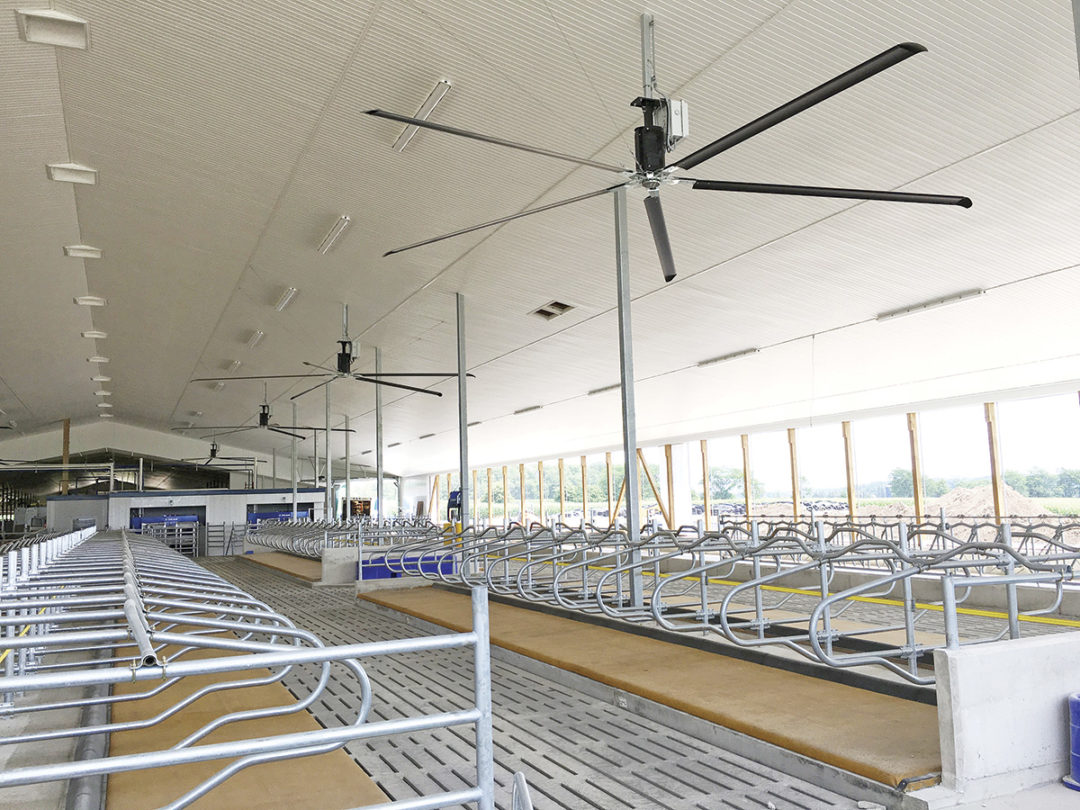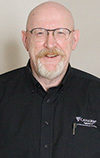Over the last 10 to 15 years, we have seen the introduction of large-diameter ceiling fans into the design of freestall dairy facilities. High-volume, low-speed (HVLS) fans were originally designed and used in large commercial warehouses and production plants, and the first livestock application was for riding arenas in the large equine markets of the U.S. From there, HVLS fans were experimented with in dairy barns and proved to be quite effective at improving cow comfort.
The purpose of HVLS fans is twofold depending on if it is operating in forward or reverse. When the fan is set to run in the forward direction, it creates a column of air the same size as the fan diameter directly downward, which then radiates a wave of air approximately 4 feet high out from the fan in a 360-degree pattern. Due to the large size of the fan blades – up to 24 feet in diameter – the air moves at high speeds, creating a velocity cooling effect for the animals as it passes over them.
Operational benefits
For hot-weather operation, HVLS fans are operated on a variable-speed basis with an automatic temperature controller. This will start the fans at a set interior temperature and speed them up or slow them down based on changes in the interior temperature. This is especially helpful during the spring and fall, when outside temperatures can vary dramatically over a 24-hour period.
During cold-weather operation, when operating in reverse, HVLS fans can be used to push air upward, which will destratify any heat that is layered along the ceiling and recirculate it gently throughout the building. Typically, this is accomplished by utilizing a variable-speed control and having the fan running at a constant speed of approximately 20%. An added benefit when operating in reverse in a natural ventilation system is: The air moves over the inside of the sidewall curtain fabric and reduces the potential for condensation buildup in cold weather.
Since HVLS fans cover large areas and use a three-phase motor, the operating costs will be lower in comparison to a larger number of small high-speed fans. In fact, in some areas of North America, the local power authorities are offering substantial rebates to encourage the purchase of HVLS fans.
In some instances, operators have found that since birds can see the slow-moving blades, they are less likely to enter the barn when these fans are operating. However, this may not always be the case. If there are perch points created where the fans are mounted, birds may still tend to roost and nest.
HVLS fans can play an important role in an inclusive fly control program that should be in place in your operation. The high-speed air flow they create within the building can also help reduce the number of flies during hot weather.
Design considerations
If you are operating a freestall dairy with large sidewall curtain openings, the fans should be mounted at a height that is above the curtain opening. Due to the length of the blade, there can be flexing in windy conditions that can cause the blade to break. HVLS fans are typically available in sizes from 8 feet to 24 feet in diameter, and the smaller units will prove to be more resistant to wind damage. It is also advisable to use a controller that has the capacity for wind sensor input so the fans can be automatically shut down in windy conditions.
In hot weather, cows will tend to stand directly under the fan where the air is coolest, so when placing the fans within the building, you should avoid having them over areas where cattle can congregate and create blockages such as scrape alleys.
When creating the fan layout, avoid having a fan mounted directly under a light fixture, as the rotation of the fan blade can cause a strobe light effect which will create an uncomfortable visual element for your cattle.
As with any ventilation system within your dairy, you should consult with a ventilation specialist who can advise you on the size and layout of HVLS fans that will work the best for you and your cows.











